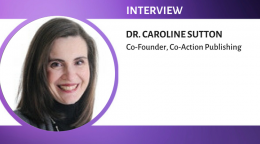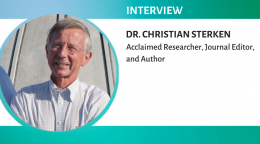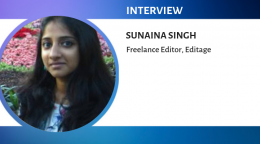New peer reviewers should learn to review their own work: Edgar Guevara

Edgar Guevara is currently a Conacyt (Mexican National Council of Science and Technology) research fellow at CIACYT-UASLP. His current research interests include non-invasive medical diagnosis, using optical imaging, functional connectivity, spectroscopy, and biomedical signal processing. His past work includes research in epilepsy, cardiovascular disease, spinal cord injury, and white matter injury in newborns. He is a member of the Mexican National System of Researchers (as Level I). He has been awarded two Conacyt scholarships to pursue his graduate studies as well as a repatriation grant. He has been the technical specialist of a telemedicine project (proinnova 2015-2016) as well as of a bilateral cooperation program, Mexico-Quebec (2016-2018). He was also Associate Professor at Universidad de las Américas Puebla Computing, Electronics and Mechatronics Department. His industrial experience includes work in the tyre industry as maintenance supervisor and projects engineer. In 2014, Edgar received his PhD in Biomedical Engineering at École Polytechnique de Montréal, where his thesis earned a special mention from the jury. He holds an MSc degree from Universidad Autónoma de San Luis Potosí and a BS in Electronic Engineering from Instituto Tecnológico de San Luis Potosí (where he was recognized as the top student in 2003).
In this interview, Edgar talks about the things he learned during his personal experience in industry as well as academia. From changing academic institutions to peer reviewing – he shares tips with researchers on a variety of aspects related to a career in research.
Your academic career is interesting! After a Bachelor’s degree in Electronic Engineering, you completed a Master’s in Applied Science, and then went on to complete a PhD in Biomedical Engineering! What made you change fields?
Well, this trajectory was not a straight path: after my Bachelor’s degree, I worked in the tyre industry for over 2 years. The joy of working in the field began to diminish when I realized that it was becoming too repetitive and decided to pursue an academic career. When I found out about non-invasive medical diagnosis during my Master’s, I decided to seriously pursue biomedical engineering. And I guess I found my true calling in academic research.
Researchers are often required to change their institution and this is one aspect they may feel extremely anxious about, especially when it involves moving to another city or country. Do you have any tips for researchers about making the transition from one academic institution to another?
The first and immediate consequence of changing institutional affiliation is a dip in productivity, which occurs naturally because of the time researchers need to spend in doing paper work, adjusting to a new system, changing lifestyles, etc. It is difficult to make the time to write and publish new papers during such phases. I would advise researchers to stay in touch with their seniors/peers from their previous institution(s). Also, consider collaborating with your colleagues from your former institution. That will make the bump in productivity less pronounced when switching institutions. As for moving to another country, I would suggest you learn the local language, even if you plan to carry out and publish research in English. I did that. I learned a new language and that made the adaptation somewhat easier for me.
Could you tell us more about the Mexican National System of Researchers?
This is an incentive-based system implemented by the Federal government. Under this system, the government gives economic incentives to researchers based on their productivity. The specific obligatory duties as part of this system include:
- Carrying out research and documenting this activity through publications (peer-reviewed articles, books, patents, etc.)
- Training highly qualified personnel, by advising students and researchers on their Master’s theses and PhD dissertations
- Performing docent activities, i.e., teaching courses at the institution you are affiliated with, even though you are primarily a researcher
- Working with evaluation committees of research proposals submitted to Conacyt-funded programs
Overall, the system is a great way to boost research in the country.
You’ve published several papers in peer reviewed journals and have considerable experience with the publication process. Now, many young researchers feel that the time taken from journal submission to final decision, including peer review, is too long. Has your experience been the same?
I agree, it usually takes too long (several months on an average), especially when evaluation from your funding agencies is approaching!
You’ve also acquired a lot of additional training and certifications. How did you make the time to work on these alongside your research?
I think that is part of the job of being a researcher: never stop learning! It is very useful, especially when you are preparing for a new academic course or expanding your research areas. In my case, I am always interested in expanding the extent of my own knowledge and that led me to look for additional training or certifications. And so I didn’t make adjustments around my research schedule to get these additional certifications. Another important advantage of this is that it adds great CV value. So even if getting an additional certification or training means you need to push yourself, do it; the discomfort is temporary. The additional training as well as experience will help you learn how to manage your time better as well as improve your own skill set.
What do you do to stay updated about the latest research in your field?
It’s extremely important for every researcher to stay updated about what’s happening in the field. I follow the social media pages of publishers and societies (such as Nature, Science, Society for fNIRS, OSA, SPIE, IEEE, Elsevier, Springer, etc.) because they post the most recent advances in science. I also visit Google Scholar regularly, where Google’s recommender system highlights newly published papers related to my field.
Your science popularization work sounds interesting. Could you tell us more about it?
In these writings, I try to explain my research to the non-initiated by relating the techniques I use with everyday examples, for instance, Hollywood movies. Once, a student mentioned that he had watched Stephen Spielberg’s movie “Minority Report”, where predictions are recorded from mutant clairvoyants through optical fibers, and he thought that probing brain activity by using light was “sci-fi” until he read my blog post on the topic. So, using the movie proved to be a good example to get more people interested in biomedical optics. This is what I mean by bringing people closer to science by relating it to commonplace things they might be interested in.
The need to bring science closer to the non-academic community, or the tax-payer, is gaining popularity. How aware are researchers about this need? And how easy or difficult would it be for researchers to undertake science popularization activities? And how can they go about it?
We are aware of this need, but science popularization is not awarded/recognized by the evaluation committees of the Mexican National System of Researchers; therefore, we must stay focused on publishing papers and we cannot go full-Sagan, no matter how important science popularization might be. But researchers can take smaller steps, such as talking about their work on social media platforms, or finding avenues to explain their work in simple words.
Based on your experience as a peer reviewer, what are some of the most common mistakes authors make in your field? How could these be avoided?
In my experience, these mistakes tend to be more common in the statistical analyses of optical imaging studies: authors tend to discuss non-significant differences in the analyzed populations, corrections for multiple comparisons are not performed, and they rarely present measures other than p-values, such as effect size. I believe this could be remediated by a good biostatistics course.
Also, when you first started reviewing academic manuscripts, how easy or difficult was it for you to get the hang of it? Do you have any tips for new reviewers?
It wasn’t easy at first. I was also very nervous initially. But as I did more and more reviews, I got more confident about my ability to be a good reviewer. It is a learning process, as everything, but so far, I have learned to be a better critic of my work. In my opinion, a good exercise for a new reviewer would be to review one of her/his own works; it helps develop fine critical thinking, which is one of the key skills a reviewer needs.
Over the years, I have come to think of time spent reviewing as a double-edged sword: on the one hand, I need to dedicate several hours a week to complete a review; on the other hand, much of my reviewing time is spent in familiarizing myself with methods or applications new to me, which helps me expand my knowledge as an early-career scientist. So peer reviewing is time well-spent, I would say.
You play multiple roles: researcher, author, reviewer, consultant, engineer, teacher…which role do you relate to the most? What are you most passionate about?
I am equally passionate about research and teaching. In my former role, I had an overload of teaching courses (an average of over 3 new courses per semester, out of 4) so I started to enjoy both activities a little less. Now, my activities are well balanced and I enjoy them all equally.
Thank you, Edgar, for this interesting conversation!
Published on: Dec 05, 2016
Comments
You're looking to give wings to your academic career and publication journey. We like that!
Why don't we give you complete access! Create a free account and get unlimited access to all resources & a vibrant researcher community.







